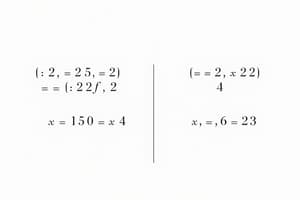Podcast
Questions and Answers
What are inverse operations in the context of solving algebraic equations?
What are inverse operations in the context of solving algebraic equations?
- Operations that result in the same output
- Operations that have the same effect on the variable
- Operations that undo each other, such as addition and subtraction, or multiplication and division (correct)
- Operations that are performed in reverse order
How would the inverse function of $f(x) = 2x + 3$ be represented?
How would the inverse function of $f(x) = 2x + 3$ be represented?
- $f^{-1}(x) = \frac{x + 3}{2}$
- $f^{-1}(x) = \frac{x - 3}{2}$ (correct)
- $f^{-1}(x) = \frac{2}{x} - 3$
- $f^{-1}(x) = 2x - 3$
What is the purpose of function composition in relation to inverse functions?
What is the purpose of function composition in relation to inverse functions?
- To simplify complex functions
- To find the derivative of a function
- To check if two functions are inverses of each other (correct)
- To combine two functions into one
In the context of inverse functions, what does $f^{-1}(f(x))$ represent?
In the context of inverse functions, what does $f^{-1}(f(x))$ represent?
What is the relationship between a function and its inverse?
What is the relationship between a function and its inverse?
What is the process of finding the inverse of a function?
What is the process of finding the inverse of a function?
What is the mathematical definition of inverse functions?
What is the mathematical definition of inverse functions?
How can we test whether the inverse of a function is a true mathematical function?
How can we test whether the inverse of a function is a true mathematical function?
What is the inverse of the function $g(x) = \(2x - 3)^{\frac{1}{2}}$?
What is the inverse of the function $g(x) = \(2x - 3)^{\frac{1}{2}}$?
What is the result of evaluating $f(f^{-1}(x))$ for the function $f(x) = (2x + 5) / 2$?
What is the result of evaluating $f(f^{-1}(x))$ for the function $f(x) = (2x + 5) / 2$?
Flashcards are hidden until you start studying
Study Notes
Inverse Operations and Inverse Functions
- Inverse operations are used to solve algebraic equations by reversing the operation to isolate the variable.
Inverse Functions
- The inverse function of $f(x) = 2x + 3$ is represented by $f^{-1}(x) = (x - 3) / 2$.
- The purpose of function composition in relation to inverse functions is to find the original value of $x$ by applying the inverse function to the output of the original function.
- $f^{-1}(f(x))$ represents the original value of $x$, which means the inverse function reverses the effect of the original function.
Characteristics of Inverse Functions
- A function and its inverse have a reciprocal relationship, meaning that one reverses the effect of the other.
- The process of finding the inverse of a function involves swapping the input and output variables and solving for the new input variable.
- The mathematical definition of inverse functions is: if $f(x) = y$, then $f^{-1}(y) = x$.
- To test whether the inverse of a function is a true mathematical function, we check if it passes the horizontal line test.
Examples and Applications
- The inverse of the function $g(x) = (2x - 3)^{\frac{1}{2}}$ is $g^{-1}(x) = \frac{x^2 + 3}{2}$.
- Evaluating $f(f^{-1}(x))$ for the function $f(x) = (2x + 5) / 2$ results in $x$, which is the original value of $x$.
Importance of Inverse Functions
- Inverse functions are essential in solving algebraic equations and are used in various mathematical and real-world applications.
Studying That Suits You
Use AI to generate personalized quizzes and flashcards to suit your learning preferences.




